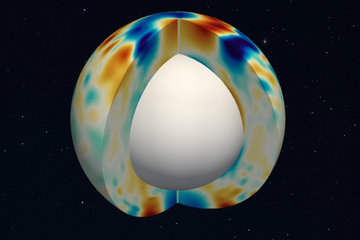All genres
1.
Journal Article
Comment on ``Neutral air turbulence and temperatures in the vicinity of polar mesosphere summer echoes'' by F.-J. Lübken, M. Rapp, and P. Hoffmann. Journal Geophysical Research 108 (D11), 4330 (2003)
2.
Journal Article
Noctilucent clouds getting brighter. Journal Geophysical Research 107 (D14), 4195 (2002)
3.
Journal Article
Polar mesospheric clouds at the South Pole: Simulations and implications for the mesopause region. Mem. British Astronom. Ass. 45, pp. 9.1 - 9.6 (2002)
4.
Journal Article
Effect of tidal variability on the mean diurnal variation of noctilucent clouds. Journal Geophysical Research 106, pp. 9749 - 9755 (2001)
5.
Journal Article
Observations of Mesospheric Summer Echoes at VHF in the Polar Cap Region. Geophysical Research Letters 28, pp. 1471 - 1474 (2001)
6.
Journal Article
Comparison between observed and computed polar mesosphere summer echoes. Journal Geophysical Research 104, pp. 11883 - 11890 (1999)
7.
Journal Article
On the diurnal variation of polar mesosphere summer echoes. Geophysical Research Letters 26 (21), pp. 3301 - 3304 (1999)
8.
Journal Article
A simple model of the ice particle size distribution in noctilucent clouds. Journal Geophysical Research 103 (D22), pp. 28743 - 28752 (1998)
9.
Journal Article
An investigation of measured temperature and VHF mesosphere summer echoes at midlatitudes. Journal Geophysical Research 102, pp. 23819 - 23828 (1997)
10.
Journal Article
A height- and time-dependent model of polar mesosphere summer echoes. Journal Geophysical Research 102, pp. 6715 - 6727 (1997)
11.
Journal Article
On the formation of electron depletions at the summer polar mesopause. Geophysical Research Letters 23, pp. 335 - 338 (1996)
12.
Journal Article
Evidence for ice clouds causing polar mesospheric summer echoes. Journal Geophysical Research 99 (D10), pp. 20937 - 20954 (1994)
13.
Journal Article
A two-ion ice particle model of the polar summer mesopause region. Journal Geophysical Research 99 (D3), pp. 5487 - 5497 (1994)
14.
Journal Article
The effect of ice particles on Thomson scattering from the polar summer mesopause region. Geophysical Research Letters 21, pp. 2721 - 2724 (1994)
15.
Journal Article
Richardsons Reim. Promet 23, p. 65 (1993)
16.
Journal Article
The formation of layered structures by parametric instability of finite-amplitude gravity waves. Advances in Space Research 12 (10), pp. (10) 203 - (10) 206 (1992)
17.
Journal Article
VHF radar observations of gravity wave critical layers in the polar summer mesopause region. Annales Geophysicae 10, pp. 887 - 894 (1992)
18.
Journal Article
Two- and three-dimensional parametric instabilites in finite-amplitude internal gravity waves. Geophys. Astrophys. Fluid Dyn. 61, pp. 1 - 25 (1991)
19.
Journal Article
VHF-Radarmessungen in der Atmosphäre. PROMET 21, pp. 50 - 55 (1991)
20.
Journal Article
VHF radar observation of gravity wave critical layers in the mid-latitude summer mesopause region. Geophysical Research Letters 18, pp. 697 - 700 (1991)











